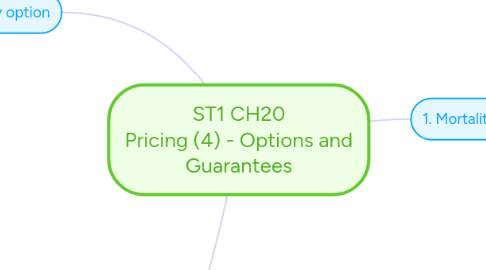
1. 2. Valuing a mortality/morbidity option
1.1. introduction
1.1.1. 2 extra assumptions required in pricing basis - prob option will be exercised, expected mortality/morbidity of those choosing to exercise.
1.2. North american method
1.2.1. Requirements: *Double (triple) decrement table for lives who have not exercised the option - decrements of death/disability, and exercising the option represented by dependent rates *Mortality/morbidity table for lives that have exercised the option *Double decrement and q'x for morb/mort post option exercise are north american components - i.e. allow for a specific proportion of lives exercising.
1.2.2. Limitations
1.2.2.1. obtaining suffice data for estimating decrement rates. NB - no direct experience. Conventional maybe preferred because of this. have detailed stats in north america, but not applicable to extent elsewhere due to underwriting, sales method etc.
1.3. Conventional method
1.3.1. Assumptions: *All eligible lives take up Mort/mort experience of take ups is ultimate corresponding to the select Basis not usually assumed to change over time, so only select and ultimate rates are used in pricing basis.
1.3.2. Limitations
1.3.2.1. *Can't use when multiple option exercise dates *Or when choice of several optios *Approximate approach is to assume worst case.
1.4. Stochastic modelling
1.4.1. Future experience projected and take up and claims propensities are investigated. large no of simulations will be tested and cost of option calculated with a particular degree of adequacy.
1.5. Summary: At option date, two groups - 1. claims experience is select 2. claims experience is higher than ultimate Group 1 incur no cost, and increase profits Group 2 incurs expcected losses, but should be covdred by option premiums paid. Those not taking up increase profits NA method more prudent depending on decrements assumptions Conventional prudent if allow for no credit for group 1, and all for group 2
2. 3. Guarantees
2.1. Resilience testing of premium rates
2.1.1. Premium rates need to be assessed to see if premium charge will be sufficient to meet outgoings with agreed level of confidence. Establishment of reserves in early years where more uncertainty.
2.2. Adequacy of reserves in pricing
2.2.1. Incorporate premium loading in pricing to cover cost of guarantee, and cost of holding guarantee reserves
2.3. Regulatory approval
2.3.1. Evidence required to judge adequacy of premiums and reserves required.
3. 1. Mortality/Morbidity options
3.1. Terms and conditions for options
3.1.1. Common for long term insurances to include options: *Additional assurance w/o evidence at normal premium rates *to renew a policy without evidence *Reinstate mortality cover after accelerated CI plan paid out for specific disease (Buy back option). T&C for exercise conditions must be clearly set out - fixed points in time, 5 years, qualifying event. Extent of the option should be specified - Addn SA < Orig sum T&C reduce selection risk against insurer i.e. poor health taking large amounts of insurance at low premiums for level of mortality/morbidity risk. Difference with life, as can take further life insurance if alive, regardless of health - take option. But if IP in payment or in deferred period don't allow exercise of the option -e.g. a dead person taking option for life insurance. if recover, eligible depending on T&C. Can only exercise option at fixed times, reducing anti selection risk.
3.2. The cost of options
3.2.1. Excess of value of premiums that should be charged in light of full underwriting, to the normal rate being charged. No cost for some lives - if good enough for select. Total expected cost depends on health status of those taking it up, and proportion choosing to take it up. smaller of exercises, worse mortality/morbidity experience will be, if substantial, on average, morbidity/mortality less extreme. Cost of option roughly {Propn exercising}x{Average extent health is worse than normal} Factors affecting health options: *Term of policy - longer have option, more likely in bad health *No times get chance to exercise *Conditions attaching to exercising: Limiting size of option *Encouragement to exercise: Take up rate - although if more healthy take up will not cause any additional expected loss and should contribute to profit. *Extra cost to PH who exercises: If steep increase in premiums, healthier may stop - lose profit *Selective withdrawals: without options maybe cheaper, so someone taking a 10 year policy may switch to without options - not collected loading, but left with unhealthy lives who will exercise.
3.2.2. Anti selection and policyholder lethargy
3.2.2.1. Concious of risk option can act against insurer, anti selection rarely a serious problem unless get serious public attention. More usual that options remain dormant. awareness and lethargy.
3.3. Constant monitoring
3.3.1. Must keep under constant review. Can come into the money particular disease onset might make option to increase coverage very costly. Not same as annuity option where all in or out of money depending on interest rates. this is individual lives health status, rare will be 100% in money for everyone. Actions: *Remove from NB *Increase standard rate premiums so recoup options costs *Stop issuing type of policies taken out under the option - would upset PH involved *Reinsure *Reduce encouragement given to policyholders.
